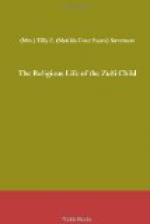BRIEF ACCOUNT OF ZUNI MYTHOLOGY.
The Pueblo of Zuni is situated in Western New Mexico on the Rio Zuni, a tributary of the Little Colorado River. The Zuni have resided in this region for several centuries. The peculiar geologic and geographic character of the country surrounding them, as well as its aridity, furnishes ample sources from which a barbarous people would derive legendary and mythologic history. A brief reference to these features is necessary to understand more fully the religious phases of Zuni child life.
Three miles east of the Pueblo of Zuni is a conspicuously beautiful mesa, of red and white sandstone, t[=o]-w[=a]-yael laen-ne (corn mountain). Upon this mesa are the remains of the old village of Zuni. The Zuni lived during a long period on this mesa, and it was here that Coronado found them in the sixteenth century. Tradition tells that they were driven by a great flood from the site they now occupy, which is in the valley below the mesa, and that they resorted to the mesa for protection from the rising waters. The waters rose to the very summit of the mesa, and to appease the aggressive element a human sacrifice was necessary. A youth and a maiden, son and daughter of two priests, were thrown into this ocean. Two great pinnacles, which have been carved from the main mesa by weathering influences, are looked upon by the Zuni as the actual youth and maiden converted into stone, and are appealed to as “father” and “mother.” Many of the Zuni legends and superstitions are associated with this mesa, while over its summit are spread the extensive ruins of the long ago deserted village. There are in many localities, around its precipitous sides and walls, shrines and groups of sacred objects which are constantly resorted to by different orders of the tribe. Some of the most interesting of these are the most inaccessible. When easy of approach they are in such secluded spots that a stranger might pass without dreaming of the treasures within his reach. On the western side of this mesa are several especially interesting shrines. About half way up the acclivity on the west side an overhanging rock forms the base of one of the pinnacles referred to. This rock is literally honeycombed with holes, from one-half to three-fourths of an inch in diameter. I visited the spot in the fall of 1884, with Professors E.B. Tylor and H.N. Moseley, of Oxford, England, and Mr. G.K. Gilbert, of the United States Geological Survey. These gentlemen could not determine whether the tiny excavations were originally made by human hands or by some other agency. The Indian’s only answer when questioned was, “They belong to the old; they were made by the gods.” Hundreds of these holes contain bits of cotton and wool from garments. In the side of this rock there are larger spaces, in which miniature vases, filled with sand, are placed. The sand is ground by rubbing stones from the same




